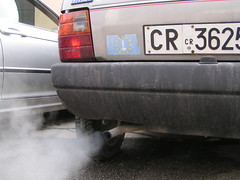 Image by Simone Ramella via FlickrThis is an example of where the precautionary principle would be helpful -- there's some evidence of the possibility of serious harm from an industrial activity, but what will happen now is that it will take a long time for the evidence to solidify, particularly in light of the typical denial-evasion-obfuscation-retaliation cycle from the affected intere$t$.
Image by Simone Ramella via FlickrThis is an example of where the precautionary principle would be helpful -- there's some evidence of the possibility of serious harm from an industrial activity, but what will happen now is that it will take a long time for the evidence to solidify, particularly in light of the typical denial-evasion-obfuscation-retaliation cycle from the affected intere$t$. What ought to happen, in these legacy cases where the activity got underway well before the science of risk assessment developed, is that the developing mosaic of suggestive studies should cause the onus to shift onto the activity ... in other words, instead of having to prove to the satisfaction of the affected industry that there is a sufficient quantum of proof to justify a serious response (which typically only happens after decades of the profit-making companies fighting against science like trapped rats), the industry ought to now have the burden of producing, within say five years, solid and valid disconfirming evidence or face a regulatory action aimed at eliminating the chance that the hazard is there.






No comments:
Post a Comment